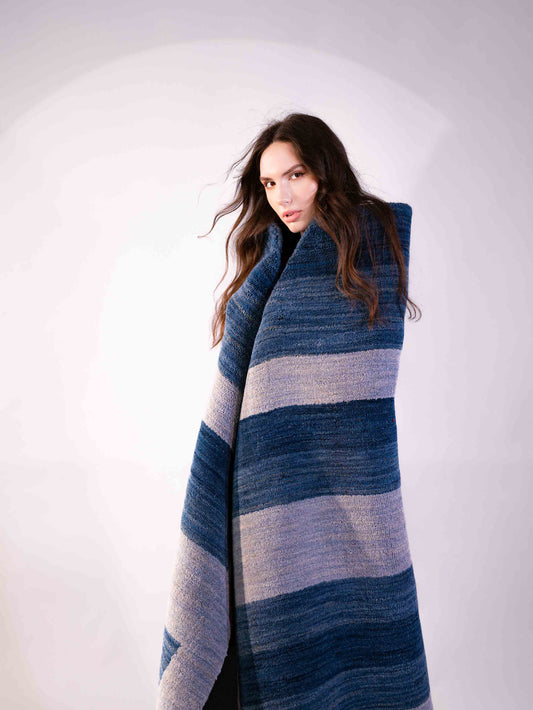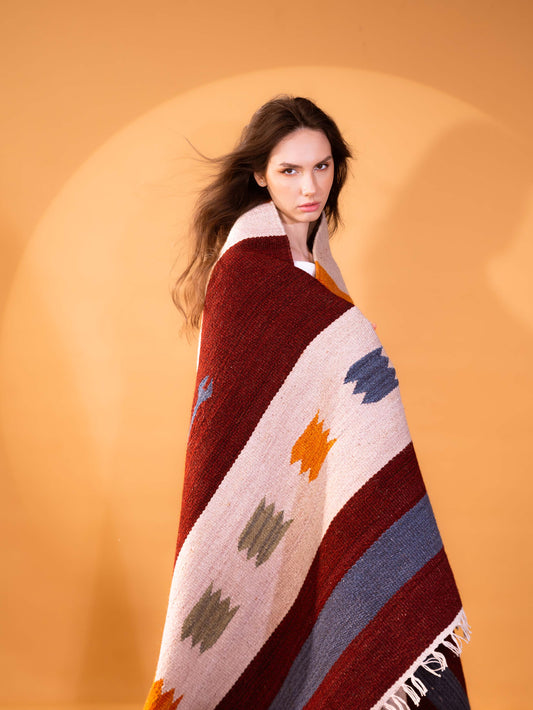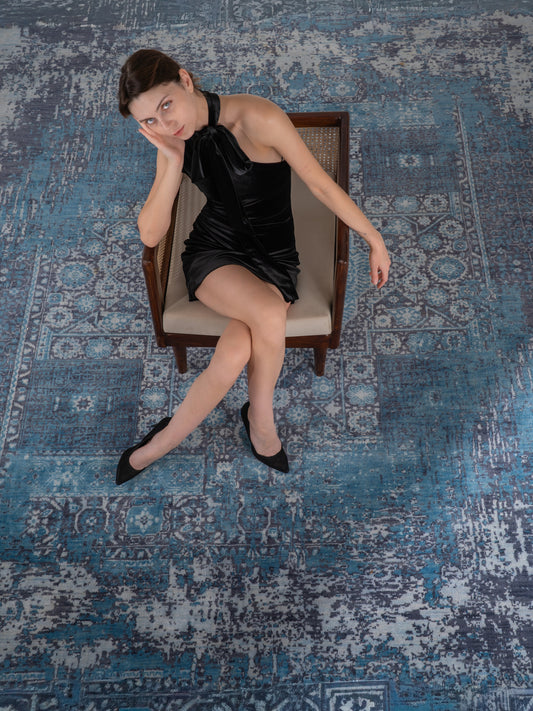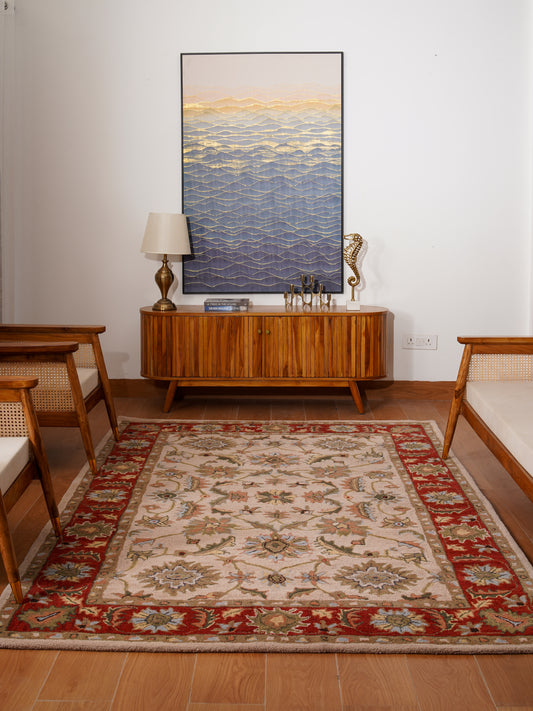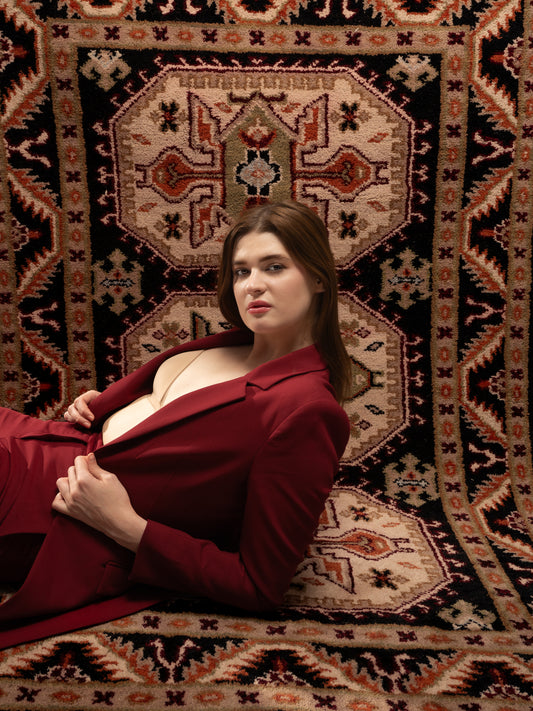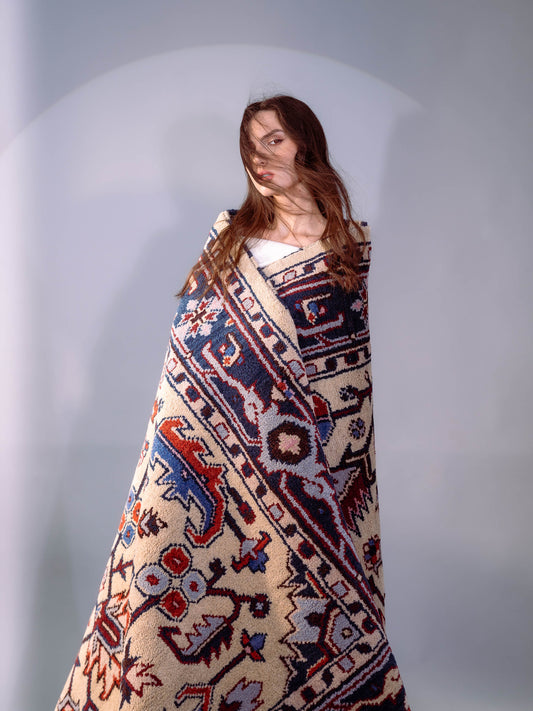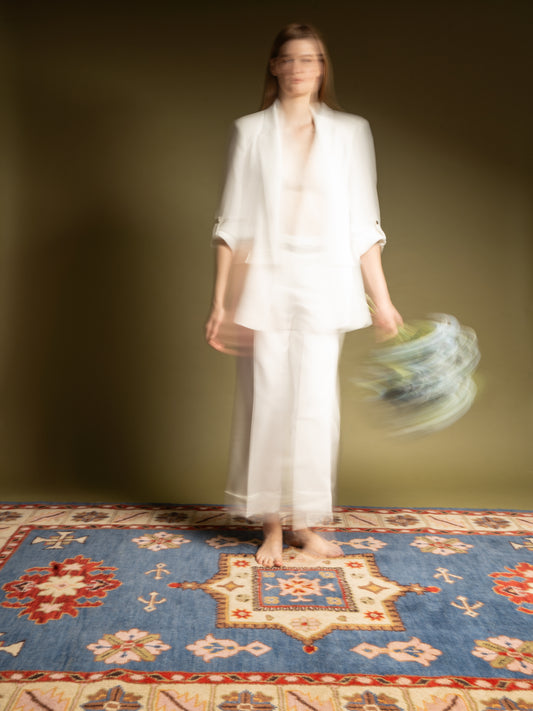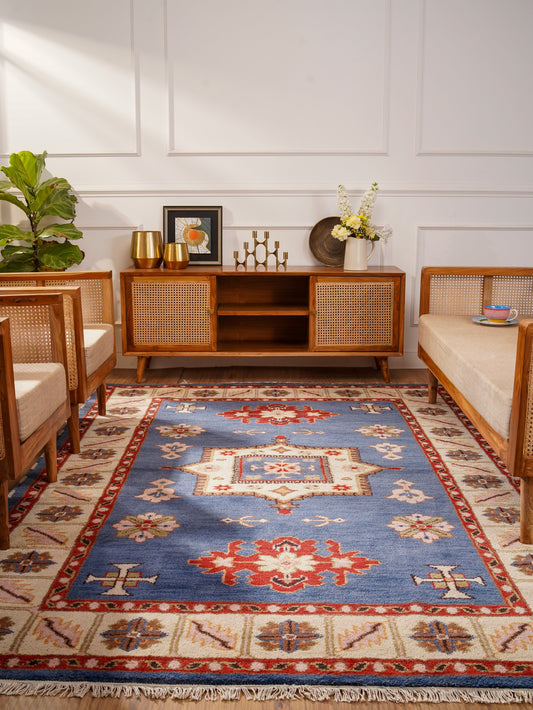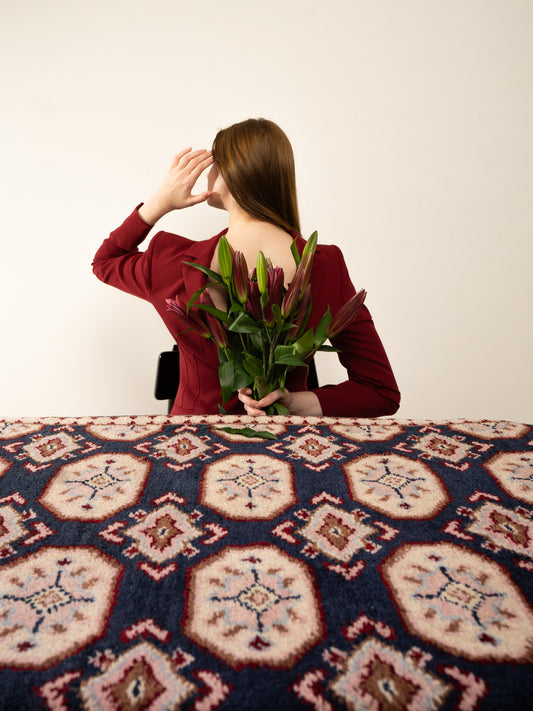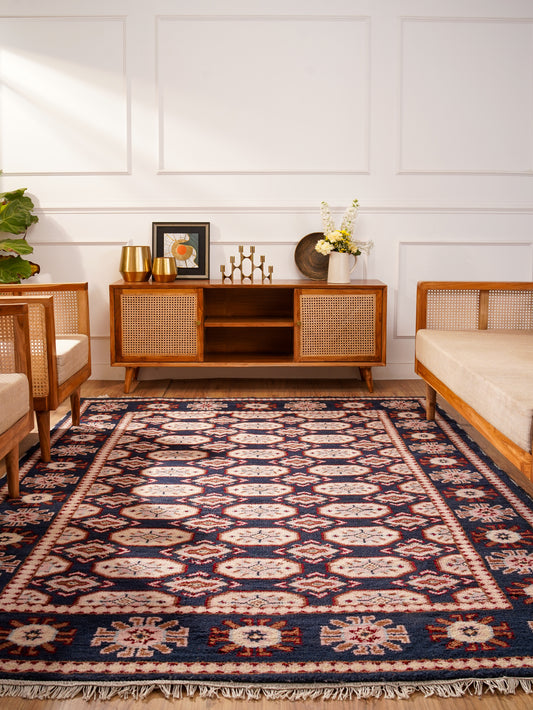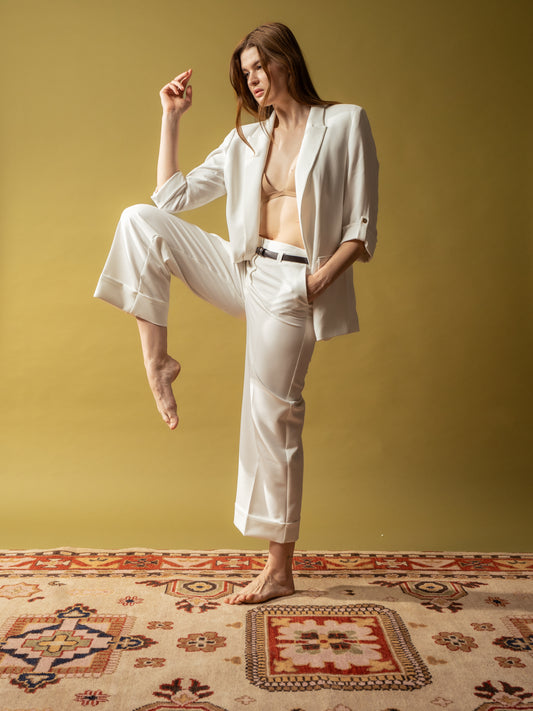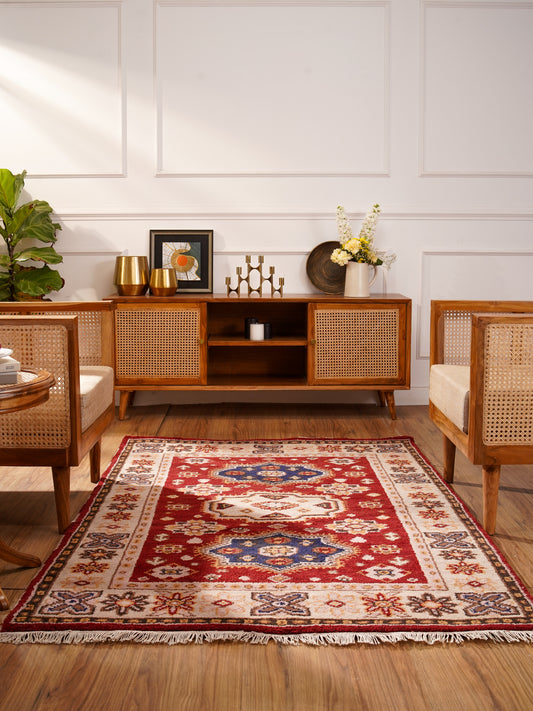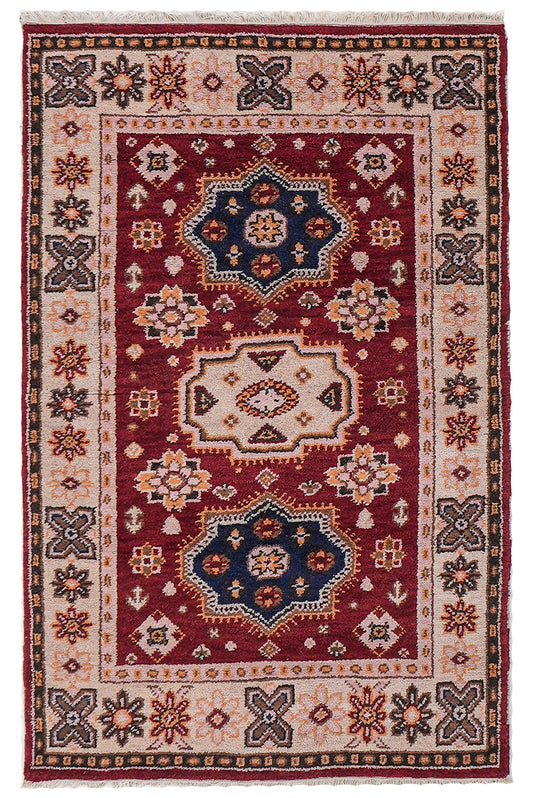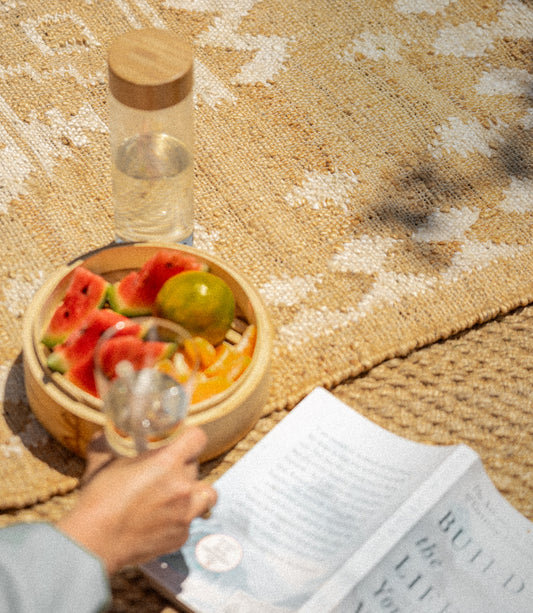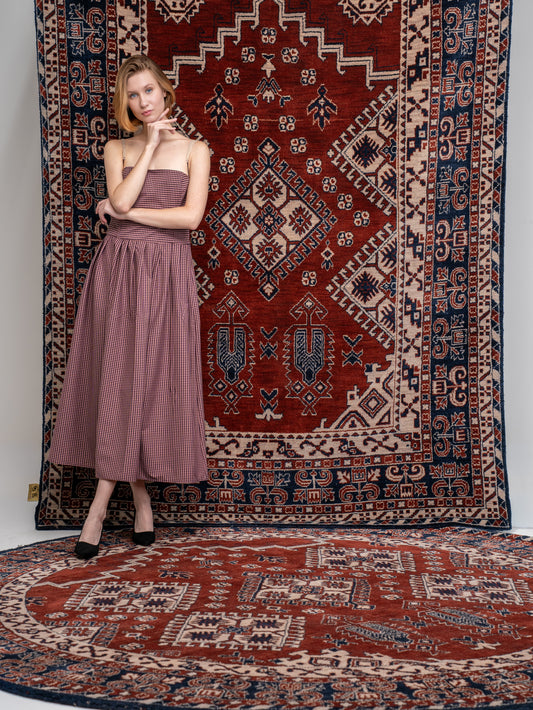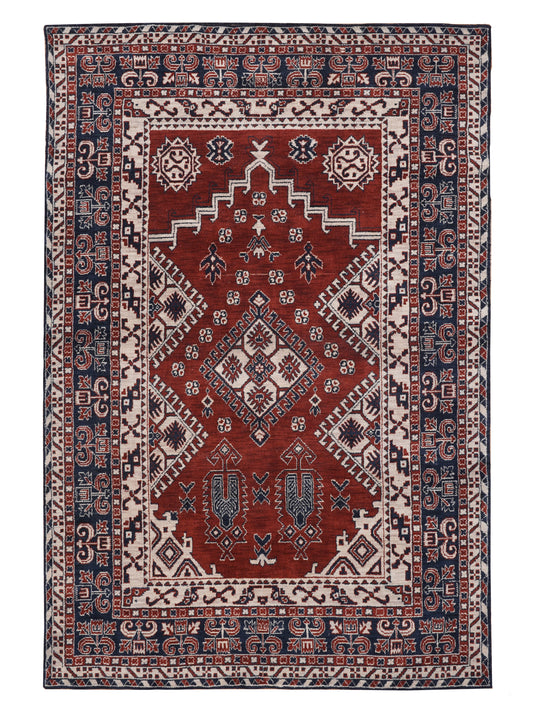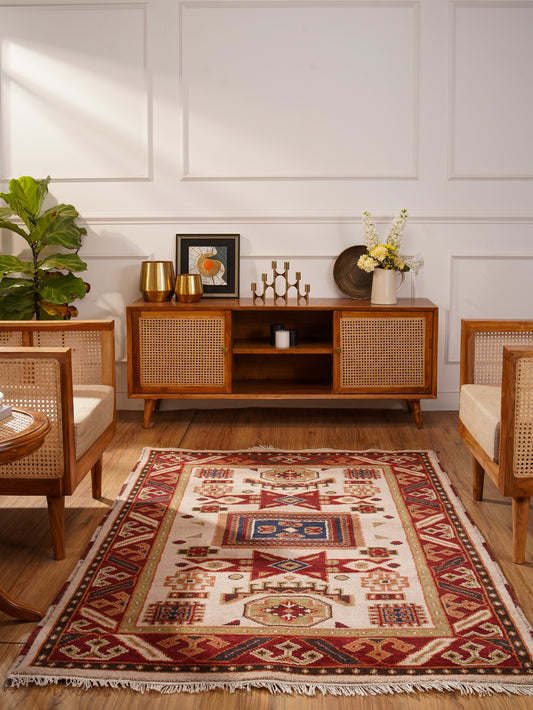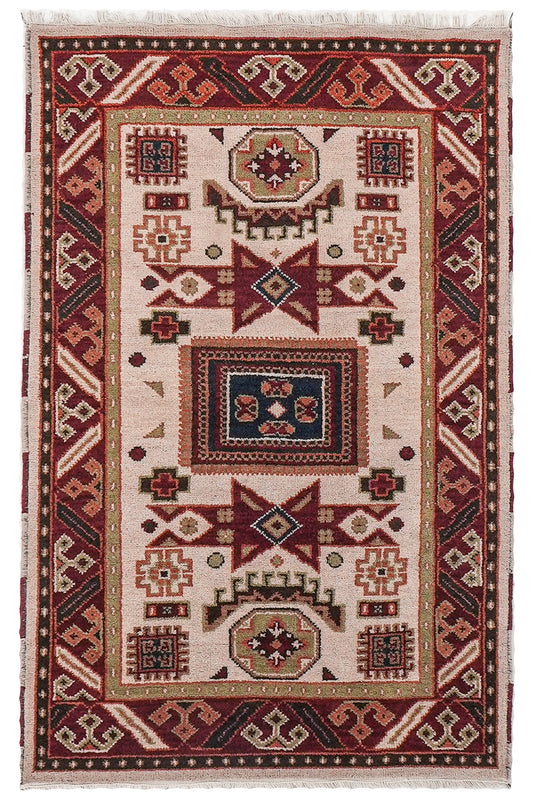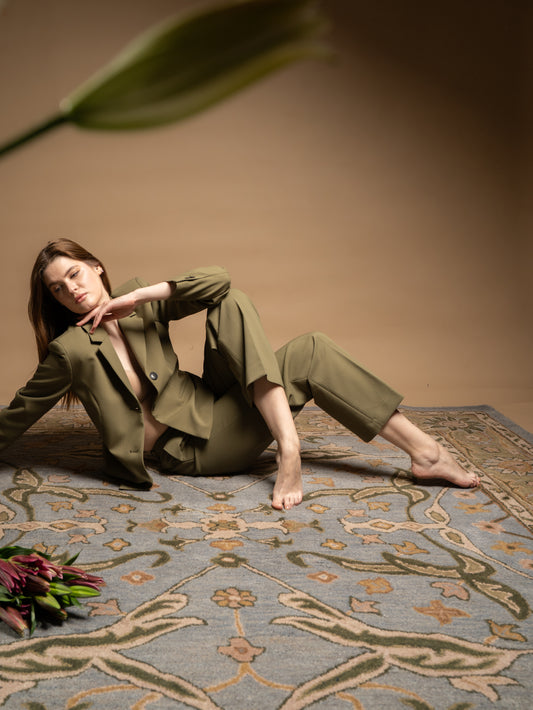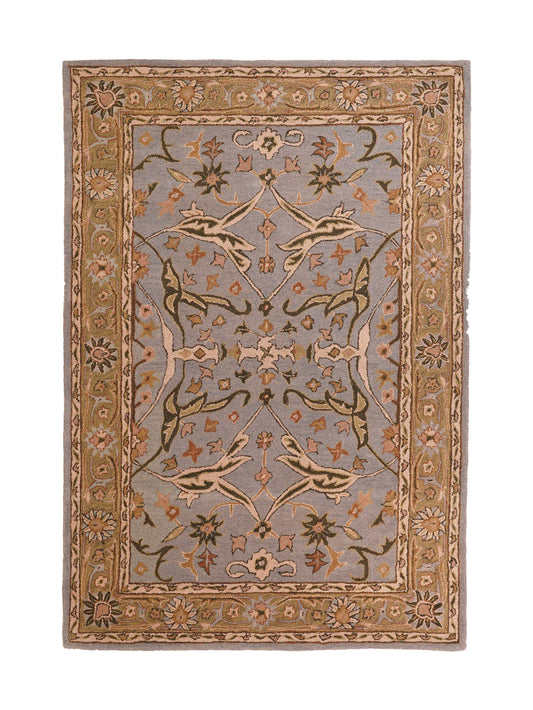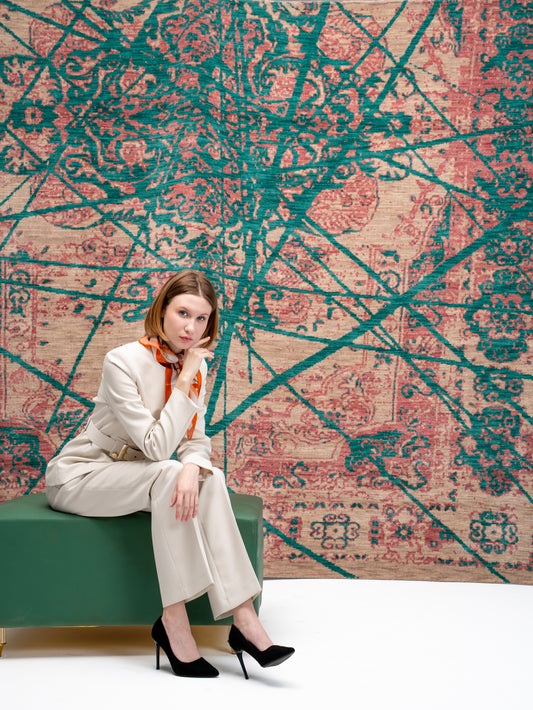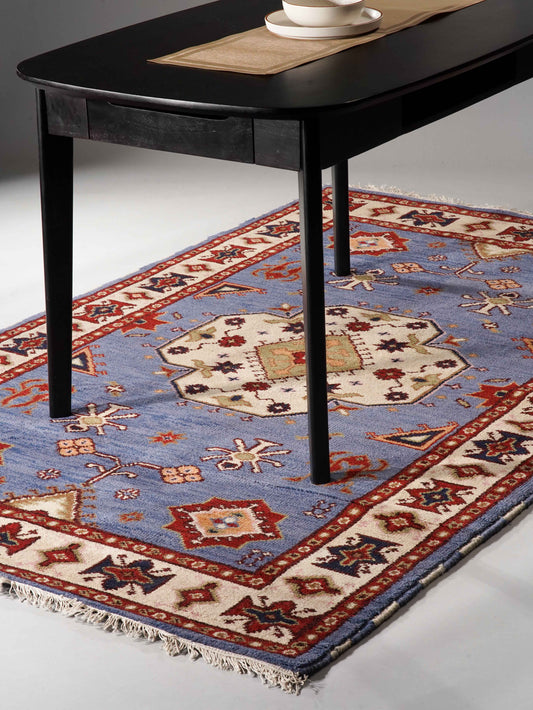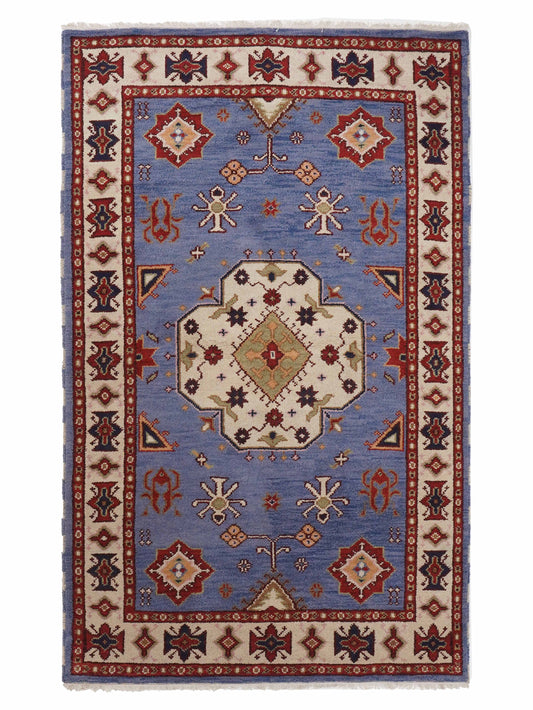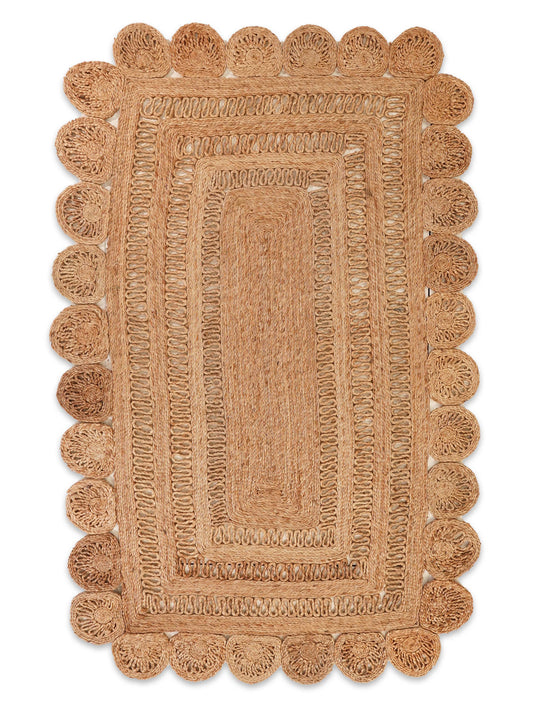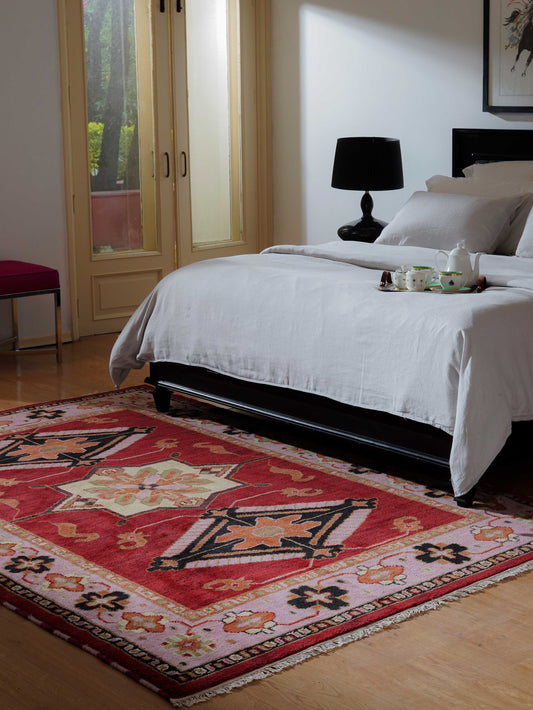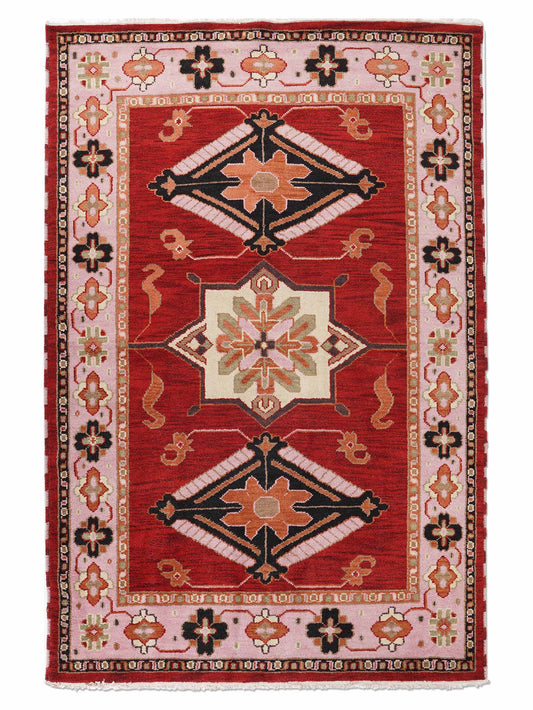-
9 size options Hand Knotted Wool Oriental Multicolor Area Rug - MulticolorProduct Description Add timeless elegance and vibrant charm to your home with this hand knotted wool oriental multicolor handmade area rug from India. Designed by skilled artisans, it reflects the beauty of traditional craftsmanship blended with enduring quality. Woven from high-quality wool material, this...Free Shipping & Free Returns
- From $109.00
$436.00- From $109.00
- Unit price
- per
Save $327.00 Off- Multicolor
-
11 size options Mahal Hand Tufted Rug - BeigeProduct DescriptionThis radiant beige red shaded wool rug brings the warmth and elegance to your surroundings. Place it anywhere right from the bedroom to the living area or dining room and enjoy its traditional designs crafted on the soft woolen piles. Its enticing oriental...Free Shipping & Free Returns
- From $119.00
$476.00- From $119.00
- Unit price
- per
Save $357.00 Off- Beige
-
8 size options Shirvan Hand Knotted Afghan Rug - BlackProduct DescriptionInclude this resplendent black and cream shaded silk wool rug to your home decor and flash about its charm in front of all. This marvelous Kazak silk wool rug will not only act as a beautiful decorative piece at your home but also...Free Shipping & Free Returns
- From $159.00
$636.00- From $159.00
- Unit price
- per
Save $477.00 Off- Black
-
13 size options Meshkin Hand Tufted Rug - BlackProduct DescriptionGet magnetize and enchanted with the resplendent appeal of this charcoal shaded wool rug. Its oriental pattern will compliment the decorative interiors and furnishings of your home. Make a flowery cover on your flooring with this wool rug and feel the warmth and...Free Shipping & Free Returns
- From $99.00
$396.00- From $99.00
- Unit price
- per
Save $297.00 Off- Black
-
7 size options Oushak Hand Knotted Afghan Rug - WhiteProduct DescriptionThe grace and elegance of this white blue shaded wool and silk rug are worth watching. Its kazak pattern contains the colors of both the modern and traditional period. You can anytime pamper your feet on its feathery kazak stuff and feel the...Free Shipping & Free Returns
- From $159.00
$636.00- From $159.00
- Unit price
- per
Save $477.00 Off- White
-
8 size options Sardarabad Hand Knotted Afghan Rug - BlueProduct DescriptionPossess this hand knotted afghan wool rug in the shades of aqua and white color to get applauded by your guests for the perfect interior settings of your home. It has been woven by the seasoned artisans in the kazak pattern using the...Free Shipping & Free Returns
- From $159.00
$636.00- From $159.00
- Unit price
- per
Save $477.00 Off- Blue
-
6 size options Bakhtiari Hand Knotted Afghan Rug - BlackProduct DescriptionBring this stylish and modern designed Afghan wool and silk rug in bold black shade and enjoy the festivity in your living area and bedroom every day. This exclusive artwork is designed by various craftsman through hand-knotted weaving. This Kazak rug has a...Free Shipping & Free Returns
- From $159.00
$636.00- From $159.00
- Unit price
- per
Save $477.00 Off- Black
-
7 size options Yalameh Hand Knotted Afghan Rug - CreamProduct DescriptionAdd life to the flooring of your home with this cream red shaded sober wool and silk rug. Its feathery wool with silk material is pure and will remind you the warmth of the fur like stuff. It comes in an excellent antique...Free Shipping & Free Returns
- From $159.00
$636.00- From $159.00
- Unit price
- per
Save $477.00 Off- Cream
-
11 size options Ghashghai Hand Knotted Afghan Rug - RedProduct DescriptionGroove up your home interior settings in a fashionable manner with this hand knotted afghan wool and silk rug in the shades of red and cream color. Its luxurious color combination is perfectly appreciated by its Kazak pattern which blesses it with a...Free Shipping & Free Returns
- From $159.00
$636.00- From $159.00
- Unit price
- per
Save $477.00 Off- Red
-
10 size options Rugheaven Jute Braided Rug - WhiteProduct DescriptionAdd sober finishing touches to your interiors and furnishings with this white Beige hand woven flat weave Kilim jute rug that comes in a graceful antique Oriental pattern. Its appearance and looks are elegant enough to catch your sight at the first glance....Free Shipping & Free Returns
- From $89.00
$356.00- From $89.00
- Unit price
- per
Save $267.00 Off- White
-
8 size options Hand Knotted Wool Oriental Rust Blue Area Rug - Rust BlueProduct Description Add a bold and elegant touch to your home with this hand knotted wool oriental rust blue handmade area rug from India. Its vibrant hues and exquisite design make it a stunning centerpiece that instantly enhances any room. Crafted from premium wool,...Free Shipping & Free Returns
- From $109.00
$436.00- From $109.00
- Unit price
- per
Save $327.00 Off- Rust Blue
-
8 size options Ziegler Hand Knotted Afghan Rug - CreamProduct DescriptionSpruce up the appearance of your home flooring with a Kazak pattern new look as this hand knotted afghan rug in the combination of cream and burgundy color. The Wool And Silk used in crafting this kazak rug is of the best quality...Free Shipping & Free Returns
- From $159.00
$636.00- From $159.00
- Unit price
- per
Save $477.00 Off- Cream
-
9 size options Hand Knotted Wool Oriental Light Green Area Rug - Light GreenProduct Description Bring timeless charm into your home with this hand knotted wool oriental light green handmade rug from India. Crafted by skilled artisans, this piece reflects true craftsmanship and heritage. Made with premium wool material, the rug combines durability with softness, offering both...Free Shipping & Free Returns
- From $109.00
$436.00- From $109.00
- Unit price
- per
Save $327.00 Off- Light Green
-
5 size options Chobi Hand Knotted Afghan Rug - CreamProduct DescriptionIlluminate the interiors and furnishings of your home with this radiant cream and red shaded wool and silk rug that comes in a Kazak patter designs. This will be the best choice for those who believe in austerity and want to reflect the...Free Shipping & Free Returns
- From $159.00
$636.00- From $159.00
- Unit price
- per
Save $477.00 Off- Cream
-
14 size options Naein Hand Tufted Rug - BlueProduct DescriptionGet the traditional approach towards the home décor with this blue green oriental rug. Its hand tufted weaving technique gives a smooth and fine finishing that is quite commendable. The flooring of your home will get a delightful and warm covering that will...Free Shipping & Free Returns
- From $99.00
$396.00- From $99.00
- Unit price
- per
Save $297.00 Off- Blue
-
7 size options Hand Knotted Wool Oriental Beige Area Rug - BeigeProduct Description Bring timeless elegance into your home with this hand knotted wool oriental beige handmade area rug from India. A true symbol of heritage and craftsmanship, it offers a sophisticated touch that complements both classic and modern interiors. Crafted from premium wool, this...Free Shipping & Free Returns
- From $139.00
$556.00- From $139.00
- Unit price
- per
Save $417.00 Off- Beige
-
8 size options Hand Knotted Wool Oriental Light Green Beige Area Rug - Light Green BeigeProduct Description Enhance your living space with the elegance of a hand knotted wool oriental light green beige handmade rug from India. A masterpiece of craftsmanship, this area rug blends timeless tradition with modern sophistication, making it a beautiful addition to any room. Woven...Free Shipping & Free Returns
- From $109.00
$436.00- From $109.00
- Unit price
- per
Save $327.00 Off- Light Green Beige
-
8 size options Jozan Hand Knotted Afghan Rug - BlueProduct DescriptionBring this elegant blue and white shaded Kazak silk wool rug home and make your living space looks the best when it comes to the home décor. It is not easy to maintain the simplicity and grace of the decorative item all the...Free Shipping & Free Returns
- From $159.00
$636.00- From $159.00
- Unit price
- per
Save $477.00 Off- Blue
-
11 size options Luxerug Jute Braided Rug - BeigeProduct DescriptionThe modernistic oriental pattern of this beige shaded ravishing rug will surely grab the attention of viewers. Its uniqueness lays in its eco friendly jute fibers that keep the surrounding atmosphere earthly. It is artistically designed by hand woven with great finishing. This...Free Shipping & Free Returns
- From $89.00
$356.00- From $89.00
- Unit price
- per
Save $267.00 Off- Beige
-
10 size options Farahan Hand Knotted Afghan Rug - RedProduct DescriptionThe grace and simplicity of this red and beige shaded hand knotted afghan wool and silk rug in Kazak pattern will match well with your home setup. Unlike other decorative items, this single piece of rug has the potential to embellish your home...Free Shipping & Free Returns
- From $159.00
$636.00- From $159.00
- Unit price
- per
Save $477.00 Off- Red
Popular Products
- From $89.00
$356.00- From $89.00
- Unit price
- / per
- Blue
- From $89.00
$356.00- From $89.00
- Unit price
- / per
- Multicolor
- From $89.00
$356.00- From $89.00
- Unit price
- / per
- Multicolor
Popular Products
- From $89.00
$356.00- From $89.00
- Unit price
- / per
- Blue
- From $89.00
$356.00- From $89.00
- Unit price
- / per
- Multicolor
- From $89.00
$356.00- From $89.00
- Unit price
- / per
- Multicolor
America's Best Handmade Rugs Store!
Oriental Rugs
Recently Viewed Products
- $19.99
- $19.99
- Unit price
- / per
- $19.99
- $19.99
- Unit price
- / per
- $19.99
- $19.99
- Unit price
- / per
- $19.99
- $19.99
- Unit price
- / per
- $19.99
- $19.99
- Unit price
- / per
- $19.99
- $19.99
- Unit price
- / per
- $19.99
- $19.99
- Unit price
- / per
- $19.99
- $19.99
- Unit price
- / per
- $19.99
- $19.99
- Unit price
- / per
- $19.99
- $19.99
- Unit price
- / per
Discover the Beauty & Legacy of Oriental Rugs When you’re looking to elevate your home décor with a piece rich in tradition, artistry and character, oriental rugs are one of the most timeless and versatile options. From intricate patterns and rich colour palettes to enduring...
Discover the Beauty & Legacy of Oriental Rugs
When you’re looking to elevate your home décor with a piece rich in tradition, artistry and character, oriental rugs are one of the most timeless and versatile options. From intricate patterns and rich colour palettes to enduring craftsmanship, an oriental rug brings history and personality into any room. In this article we’ll explore what makes oriental rugs special, how to choose the right one, styling and care tips, and a detailed FAQ to answer your questions.
Why Choose Oriental Rugs?
Heritage, craftsmanship & artistry
Oriental rugs are more than floor‐coverings: they are handcrafted textiles that often reflect centuries of weaving tradition. Whether Persian, Turkish, Caucasian, or Central Asian in origin, the term “oriental rugs” evokes rich motifs, symbolic design, and durable materials. For example, types such as the Heriz rug from Iran are celebrated for their bold geometric medallions and resilient wool construction.
Visual richness & versatility
The beauty of oriental rugs lies in their rich palettes (deep reds, navy, golds, ivory) and complex patterns—medallions, floral arabesques, hunting scenes, tribal geometry. This gives them the power to be the focal point of a room or to tie together a eclectic décor as a unifying element.
Quality & durability
Because many oriental rugs are hand‐knotted or hand‐woven in wool, cotton or silk, their durability is high—meaning your investment in an oriental rug can last for decades if properly cared for. A well-made oriental rug brings both aesthetic and functional value.
Style adaptability
Despite their traditional roots, oriental rugs fit many décor styles: classic, bohemian, modern eclectic, transitional, even minimalist when used thoughtfully. A timeless oriental rug adds texture and depth to floors, and often becomes a design anchor.
How to Choose the Right Oriental Rug
Choosing the right oriental rug involves more than picking a pretty design—it requires consideration of size, material, pattern scale, colour, room use and décor context.
1. Size & shape
- Living Room: Ideally the oriental rug should be large enough so the front legs of sofas and chairs sit on it, or even all legs in a larger space.
- Dining Room: Ensure the rug extends beyond the dining table so chairs remain on the rug when pulled out.
- Bedroom: A large oriental rug under the bed that extends on sides creates luxury; smaller rugs at foot or side work too.
- Entry / Hallway / Runner: Narrow, longer oriental rugs can define these spaces.
When checking your oriental rugs collection, filter by size to match your room layout.
2. Material & construction
- Wool: Common and durable, gives a soft pile and warm feel.
- Silk: Luxurious, high-sheen, but more delicate and higher cost.
- Wool & Silk blend: Combines durability + sheen.
- Cotton / flat‐weave: Lower pile, easier to maintain.
Construction: Hand‐knotted (highest quality), hand‐woven, machinemade. The term “oriental rugs” often refers to hand‐crafted versions with traditional techniques.
If your usage is heavy (kids, pets, traffic), prioritize durable material and tighter knotting.
3. Pattern & colour scale
- Large medallion, heavy border: traditional style.
- All-over pattern, floral, tribal: different effect.
- Colour: Deep reds, navy blues, golds, ivories are common. Internal motifs often use accent colours.
When you choose an oriental rug from the collection, pick a pattern and colour that complements your room—either by matching some hues or letting the rug become the accent.
4. Room lighting & décor context
- In dark rooms: Lighter ground colours or rugs with ivory/cream areas help brighten.
- In bright rooms or rooms with a lot of natural light: deeper, saturated colours will hold up and not wash out.
- Your furniture, walls and flooring should be considered: If you have plain neutral furniture, an oriental rug can bring in pattern and colour; if you already have bold wallpaper or upholstery, consider a more subdued oriental rug.
5. Maintenance & location
- High traffic area? Use durable material and pile height.
- Entryway or dining? Consider ease of cleaning, pile resistance.
- Place with pad underneath for grip and to protect flooring beneath.
Oriental rugs are investments: choosing the appropriate use zone will ensure longevity.
Styling Tips for Oriental Rugs
Living Room
Place your oriental rug beneath the primary seating area. If you have a neutral sofa and chairs, the oriental rug brings in colour and pattern richness. Use accent cushions that pull one or two colours from the rug to tie everything together. Metallic lamps, wooden side‐tables and warm lighting complement the richness of oriental rugs.
Bedroom
An oriental rug under the bed adds luxury. For a more subtle effect, place an oriental rug at the foot of the bed or along one side. When your bedding is neutral, the oriental rug can become the decorative highlight. If your room décor is more decorative, choose an oriental rug with a smaller pattern and more muted palette.
Dining Room
Under the dining table an oriental rug defines the dining zone and adds warmth. Choose a size that ensures chairs remain on the rug when pulled. Because oriental rugs often have rich patterns and darker tones, they are good at hiding minor stains and wear in dining contexts.
Entryway / Hallway
A narrow runner style oriental rug makes a grand first impression. Look for patterns and colour that align with your home’s entrance décor. Because foot traffic is high, select durable woven construction.
Layer & Accent
You don’t always need the oriental rug to cover the entire floor. You can layer a smaller oriental rug on top of a larger neutral rug for a curated look. Or use an oriental rug only in a reading nook or under a statement chair.
Colour Pairings
- Oriental rugs (deep red/navy) + neutral furniture (cream, beige, grey): balanced and classic.
- Oriental rugs + wood tones (walnut, mahogany): warm, grounded.
- Oriental rugs + metallics (brass, gold): luxe, elegant.
- Oriental rugs + modern furniture: brings together old and new for a transitional style.
Benefits of Shopping the “Oriental Rugs” Collection at GetMyRugs
- Curated selection: The collection offers a variety of styles, sizes, materials in the “oriental rugs” category—making it easier to find the right one for your space.
- Quality & value: You get access to high-quality materials and weaving techniques, meaning your oriental rug will perform and last.
- Ease of shopping: With filters for size, shape, material, colour, you can streamline your search within oriental rugs.
- Design flexibility: Because oriental rugs are timeless, choosing one from this collection means you can update other décor elements over years without needing to replace the rug.
- Adaptable to Indian homes: For Indian flooring, furniture and décor conditions (tile, marble, wood; heavy use; varied lighting), the oriental rugs from the collection provide robust styling and durability.
Care & Maintenance of Your Oriental Rug
Vacuum regularly
Keep dust and grime from settling into the pile of your oriental rug. Vacuum at least once a week. For delicate hand‐woven oriental rugs, use gentle suction without aggressive beaters.
Rotate periodically
If your oriental rug is exposed to direct sunlight or one side sees more traffic, rotate it 180° every 3–6 months to ensure even wear and fading.
Blot spills immediately
Accidents happen, especially in busy homes. With an oriental rug, act quickly: blot with a clean white cloth, avoid rubbing. Because oriental rugs often contain multiple colours, a spill on a light portion stands out more.
Use a rug pad
A quality pad underneath your oriental rug adds cushioning, protects the floor beneath, reduces slip and helps extend life of the rug. Especially recommended on tile, marble floors which are common in Indian homes.
Avoid excessive direct sunlight
Sun can fade colours over time. If your oriental rug is in a sunlit room, close blinds during peak hours, and consider rotating regularly.
Professional cleaning
Every 12–24 months (depending on use), have your oriental rug professionally cleaned. This restores pile, vibrancy and removes deep-down dust.
Furniture & heavy items
Legs of heavy furniture can squash rug pile. Use furniture pads or glides under legs and avoid leaving very heavy items on soft rugs for long durations without repositioning.
Humidity & airflow considerations (for Indian context)
In humid climates, ensure the floor under the oriental rug is dry, allow airflow, and occasionally lift to check under the rug to prevent mildew or odours. On marble or tile floors, use a breathable pad.
Trends & Inspirations in Oriental Rugs
Revival of patterned & colour-rich rugs
Design trends in 2025 show a resurgence of interest in richly patterned oriental rugs. They are becoming “statement pieces” again, as opposed to fading into the background.
Mix of traditional and contemporary
While the term “oriental rugs” evokes classic styles, many modern adaptations use traditional motifs in contemporary colourways or scaled patterns, making them suitable for modern interiors.
Sustainability & craftsmanship
Customers are increasingly interested in ethically made, hand‐crafted rugs with natural materials. Oriental rugs—when made traditionally—fit this trend, offering authenticity and longevity.
Colour reinvention
While classic red/navy/ivory palettes remain popular, we’re seeing oriental rugs in softened colourways, muted tones, and even blended with modern minimal aesthetic. This flexibility makes them adaptable across styles.
Indian home décor synergy
In Indian homes—where floors may be marble, tile or wood, and décor rich with colour and texture—oriental rugs integrate beautifully. They bring warmth, pattern and richness into spaces that often mix contemporary and traditional elements.
Choosing Oriental Rugs: Quick Reference
- Use Case: Living rooms, bedrooms, dining rooms, entryways, reading corners
- Colour Themes: Deep reds, navy blues, golds, ivories, accent colours
- Sizes & Shapes: Rectangular, square, runner; matching room layout
- Materials: Wool, wool-silk blends, cotton foundations; hand‐knotted, hand‐woven
- Benefits: Rich aesthetic, design anchor, longevity
- Care Needs: Regular vacuuming, spot cleaning, rug pad, rotation, professional cleaning
FAQ – Frequently Asked Questions about Oriental Rugs
Q1: What exactly qualifies as an “oriental rug”?
A1: While definitions vary, “oriental rugs” generally refer to floor rugs woven by hand (or in some cases machine but in traditional styles) in regions such as the Middle East, Persia (Iran), Turkey, Caucasus, Central Asia or India. They are characterised by motifs, patterns, weaving techniques and materials typical of those regions. For example the Heriz and Bakshaish rugs from Iran are examples.
Q2: How do I choose the right size oriental rug for my space?
A2: Measure your room and furniture layout. In a living room you want the rug large enough that the seating area is unified. In dining rooms allow for chair movement. For smaller spaces use smaller rugs or runners. Your oriental rugs collection likely has size filters—use them to match your layout.
Q3: Are oriental rugs expensive and are they worth it?
A3: Quality hand‐knotted oriental rugs often cost more because of craftsmanship, materials and longevity. Whether “worth it” depends on how much you value the aesthetic, durability and heritage. If you buy a well‐made oriental rug and care for it, it can last decades and become a key element of your décor.
Q4: Will an oriental rug fit with modern décor or only traditional interiors?
A4: Yes—they fit both. While rooted in tradition, oriental rugs can be styled in modern, minimalist or eclectic spaces. The key is colour and scale: if your décor is modern and sparse, an oriental rug adds warmth and pattern; if traditional, it continues the theme. The stylised patterns and rich colours make them quite versatile.
Q5: How do I maintain an oriental rug in a high-traffic area?
A5: Select a durable material (wool, tighter knot count); use a good rug pad; vacuum without aggressive brush; rotate periodically; address spills immediately; professional clean regularly. In a high-traffic zone you may want a more robust weave or lower pile height.
Q6: My home has marble or tile floors—is an oriental rug suitable?
A6: Absolutely. On cold surfaces (marble/tile) an oriental rug provides both visual warmth and actual comfort. Use a rug pad to avoid slippage and to give some cushioning. The rich patterns of oriental rugs also mask minor dust or footprints better than very pale plain rugs.
Q7: What colours should I choose in an oriental rug to match my existing décor?
A7: Look at your room’s furniture, wall colour, flooring and accents. Pick an oriental rug that includes one or more colours present in your décor or choose one that offers a contrast you like. For example a room with neutral furniture can benefit from a rug with deep red/navy and gold accents. If your décor is already colourful, a rug with more muted tones might be better.
Q8: Will the rug’s colours fade or look different in real life?
A8: Possibly. Screen images may misrepresent colour; lighting in the room also shifts perception. If possible view a sample, or consider how the rug looks under your room’s lighting at different times. Also avoid placing the oriental rug in direct harsh sunlight for extended periods.
Q9: What is the expected lifespan of a quality oriental rug?
A9: With good materials (wool, solid foundation), proper care (vacuuming, spot cleaning, professional cleaning) a quality oriental rug can last many years—10, 20, even decades in some cases. The investment is in both aesthetic and durability.
Q10: I live in India—what special considerations should I keep in mind when buying an oriental rug?
A10: Yes—consider these:
- Flooring type (tile, marble, wood): use appropriate rug pad, consider ventilation/under‐rug moisture.
- Climate/humidity: ensure airflow beneath, avoid mould or dampness under rug.
- Size of rooms: Indian rooms sometimes differ in proportions—check size carefully.
- Traffic/usage: Heavy foot traffic, kids, pets—select durable weave and consider cleaning ease.
- Style/furnishings: Indian interiors often mix rich fabrics, textures and colours—oriental rugs fit beautifully here as they bring pattern and richness that complements that tradition.
Final Thoughts
An oriental rug is far more than simply a floor‐covering—it’s a statement, a piece of art, and a design anchor. Whether you are drawn to a classic Persian medallion rug or a tribal Caucasian piece, the right oriental rug brings texture, colour and story into your home.
When browsing the “Oriental Rugs” collection, use size, shape, material and colour filters, consider your room’s lighting, décor and usage, and invest time in selection and care. With the right choice and upkeep, your oriental rug will become a beloved element of your interior for many years.
- Choosing a selection results in a full page refresh.

